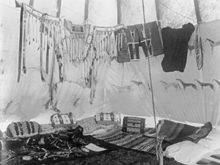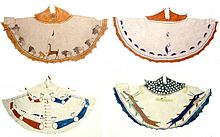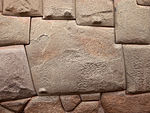
A tipi or tepee (/ˈtiːpi/ TEE-pee) is a conical lodge tent that is distinguished from other conical tents by the smoke flaps at the top of the structure, and historically made of animal hides or pelts or, in more recent generations, of canvas stretched on a framework of wooden poles. The loanword came into English usage from the Dakota and Lakota languages.
Historically, the tipi has been used by certain Indigenous peoples of the Plains in the Great Plains and Canadian Prairies of North America, notably the seven tribes of the Sioux, as well as among the Iowa people, the Otoe and Pawnee, and among the Blackfeet, Crow, Assiniboines, Arapaho, and Plains Cree. They are also used west of the Rocky Mountains by Indigenous peoples of the Plateau such as the Yakama and the Cayuse. They are still in use in many of these communities, though now primarily for ceremonial purposes rather than daily living. Modern tipis usually have a canvas covering.
Non-Native people have often stereotypically and incorrectly assumed that all Native Americans in the United States and Indigenous peoples in Canada have at one point lived in tipis, which is inaccurate, as many Native American cultures and civilizations and First Nations from other regions have used other types of dwellings (pueblos, wigwams, hogans, chickees, and longhouses).
Terminology and etymology


Tipi is a loanword from the Dakota and Lakota language. Stephen Return Riggs' 1852 Dakota-English dictionary, which was sponsored by the Minnesota Historical Society spells it as tipi. Eugene Buechel spells it as tipi in his Lakota-English dictionary. Dakota ethnographer Ella Deloria used the spelling tipi throughout her writings, including in her essential book The Dakota Way of Life. Lakota linguist Albert White Hat developed his own Lakota orthography and used tipi as the spelling. The tipi image is used on almost all Dakota/Lakota tribal flags or seals, and tipi is the spelling used by Dakota and Lakota tribes today.
The spelling tipi is the one most common in Canadian English whereas the spelling tepee is the most common one according to American English dictionaries and the Encyclopedia Britannica and the Columbia Electronic Encyclopedia.
The wigwam or "wickiup", a dome-shaped shelter typically made of bark layered on a pole structure, was also used by various tribes, especially for hunting camps. The term wigwam has often been incorrectly used to refer to a conical skin tipi.
The conventional translation in French and English for all Indigenous dwellings at one time was "lodge," resulting in many compounds and place names such as sweatlodge, lodgepole pine, Red Lodge, and so on.
Types and utility
Structure
A tipi is distinguished from other conical tents by the smoke flaps at the top of the structure. The tipi is durable, provides warmth and comfort in winter, is cool in the heat of summer, and is dry during heavy rains. Tipis can be disassembled and packed away quickly when people need to relocate and can be reconstructed quickly upon settling in a new area. Historically, this portability was important to Plains Indians with their at-times nomadic lifestyle. Tribes would have well-organized camp circles of family units living in multiple tipis arranged in order depending on rank or roles in the family unit, community, or ceremony. Generally, the door and camp openings face east in the direction of the sunrise.
A typical family tipi is a conical, portable structure with two adjustable smoke flaps, multiple poles (historically from 12 to 25 ft or 3.7 to 7.6 m long) called lodge poles.
Lewis H. Morgan noted that tipi frames were 13 to 15 poles that were 4.6 to 5.5 metres (15–18 ft) tall. These poles, "after being tied together at the small ends, are raised upright with a twist so as to cross the poles above the fastening." The builders pull the lower ends out to form a circle about 3.0 metres (10 ft) in diameter on the ground. They stretch a covering of tanned and untanned buffalo hides, sewn together, over the frame, which they then secure with stakes at the base. "At the top there is an extra skin adjusted as a collar, so as to be open on the windward side to facilitate the exit of the smoke. A low opening is left for a doorway, which is covered with an extra skin used as a drop. The fire-pit and arrangements for beds are the same as in the Ojibwa lodge, grass being used in the place of spruce or hemlock twigs."
Lodgepole pine is the preferred wood in the Northern and Central Plains and red cedar in the Southern Plains. Tipis have a detachable cover over the structure. The cover has historically been made of buffalo hide, an optional skin or cloth lining, and a canvas or bison calf skin door. Modern lodges are more often made of canvas.
Ropes (historically rawhide thongs or babiche) and wooden pegs are required to bind the poles, close the cover, attach the lining and door, and anchor the resulting structure to the ground. Tipis are distinguished from other tents by two crucial elements: the opening at the top and the smoke flaps, which allow the dwellers to heat themselves and cook with an open fire; and the lining that is primarily used in the winter, which insulates. Tipis were designed to be easily set up or taken down to allow camps to be moved to follow game migrations, especially the bison. When dismantled the tipi poles were used to construct a dog- or later horse-pulled travois on which additional poles and tipi cover were placed.
Tipi covers are made by sewing together strips of canvas or tanned hide and cutting out a semicircular shape from the resulting surface. Trimming this shape yields a door and the smoke flaps that allow the dwellers to control the chimney effect to expel smoke from their fires. Old-style traditional linings were hides, blankets, and rectangular pieces of cloth hanging about 1.2 to 1.5 metres (4–5 ft) above the ground tied to the poles or a rope.
Decoration

Historically, most tipis in a village were not painted. Painted tipis often depicted noteworthy historical battles and often featured geometric portrayals of celestial bodies and animal designs. Sometimes tipis have been painted to depict personal experiences such as war, hunting, a dream, or vision. When depicting visions, "ceremonies and prayers were first offered, and then the dreamer recounted his dream to the priests and wise men of the community. Those known to be skilled painters were consulted, and the new design was made to fit anonymously within the traditional framework of the tribe's painted tipis."
During the later reservation era, retired warriors would paint on canvas tipis depicting different events in tribal history, including battles with Americans. He Nupa Wanica (Joseph No Two Horns), a Hunkpapa Lakota warrior who fought in 40 battles, including the Battle of the Little Bighorn, is one such artist known for his many tipi paintings, shields and horse effigies now in museums.
Teachings

Tribes today use the tipi as a means to convey traditional, scientific, and psychological teachings. The Siksika (Blackfoot) nation's worldview is based on the shape of a tipi, which inspired Maslow's hierarchy of needs teachings. In Cree communities, the tipi can represent the power of women and their role as the foundation of the family unit. In Lakota communities, youth are taught how to assemble tipis, with each pole representing different traditional virtues, and are simultaneously taught geometry and teamwork.
See also
- Chum (tent), a similar structure used by various peoples from northwestern Siberia to northern Mongolia.
- Goahti, a somewhat similar structure used by the Sami people of northern Scandinavia
- Lavvu, a conical tent covered with reindeer hides, used by the Sámi people of northern Scandinavia
- Plains hide painting
Notes and references
- General
- Holley, Linda A. Tipis, Tepees, Teepees: History and Design of the Cloth Tipi. Gibbs-Smith, 2007.
- Reginald Laubin, Gladys Laubin, Stanley Vestal, The Indian Tipi: its History, Construction, and Use. Norman: University of Oklahoma Press, 1989, ISBN 978-0-8061-2236-6.
- American Anthropologist. Vol. 16; No. 1. American Anthropological Association of Washington, 1914.
- Citations
- "English to Dakota Dictionary: As Spoken by the Sisseton-Wahpeton Oyate". Dakota-English Dictionary. Retrieved June 28, 2022.
- Yellowhand (November 29, 2013). "Lakota Pronunciation Glossary". WoLakota Project. Retrieved July 5, 2022.
- Lewis H. Morgan, "I have seen it in use among seven or eight Dakota sub-tribes, among the Iowas, Otoes, and Pawnees, and among the Black-feet, Crows, Assiniboines, and Crees. In 1878, I saw it in use among the Utes of Colorado. A collection of fifty of these tents, which would accommodate five hundred persons, make a picturesque appearance. Under the name of the "Sibley tent" it is now in use, with some modifications of plan, in the United States Army, for service on the plains." (Contributions to N. A. Ethnology, vol. iv., p. 115.)
- ^ Laubin, Reginald; Laubin, Gladys (2012). The Indian Tipi: Its History, Construction, and Use (2 ed.). University of Oklahoma Press. ISBN 978-0806188522.
- National Museum of the American Indian (2007). Do All Indians Live in Tipis?. New York: HarperCollins. ISBN 978-0-06-115301-3.
- Keoke, Emory Dean; Porterfield, Kay Marie (2009). Encyclopedia of American Indian Contributions to the World: 15,000 Years of Inventions and Innovations. Infobase Publishing. p. 264. ISBN 978-1-4381-0990-9.
- Riggs, Stephen Return (1992). A Dakota-English Dictionary. St. Paul: Borealis Book S. p. 470. ISBN 978-0-87351-282-4.
- Buechel, E.; Manhart, P. (1970). A Dictionary of the Teton Dakota Sioux Language; Lakota-English, English-Lakota: With Considerations Given to Yankton and Santee. Oie Wowapi Wan̳ Lakota-Ieska, Ieska-Lakota. Red Cloud Indian School, Holy Rosary Mission. Retrieved November 6, 2023.
- Deloria, Ella Cara (2022-12-22). The Dakota Way of Life. Lincoln: U of Nebraska Press. p. 76. ISBN 978-1-4962-3359-2.
- White Hat Sr, Albert (1999). Reading and Writing the Lakota Language. Salt Lake City: University of Utah Press. p. 35. ISBN 978-0-87480-572-7.
- "Sioux Indians". AAA Native Arts. Retrieved November 6, 2023.
- "Dakota-English Dictionary". Dakota-English Dictionary. Retrieved November 6, 2023.
- Ullrich, Jan F. (2008). New Lakota Dictionary. Bloomington: Lakota Language Consortium. ISBN 978-0-9761082-9-0.
- "Lakota Pronunciation Glossary". WoLakota Project. November 29, 2013. Retrieved November 6, 2023.
- "Lakota Tipi : Aktá Lakota Museum & Cultural Center". Aktá Lakota Museum & Cultural Center. April 20, 2022. Retrieved November 6, 2023.
- Tipi in the Canadian Encyclopedia
- Tepee in the Merriam-Webster Dictionary
- Tepee in the American Heritage Dictionary
- Tepee in the Encyclopedia Britannica
- Tepee in the Columbia Electronic Encyclopedia
- The Mythology of All Races. 1916. |p. 76.
- The Archeological History of New York, Issues 231-238. By Arthur Caswell Parker. University of the State of New York, 1922. p387
- The North-Americans of yesterday. By Frederick Samuel Dellenbaugh. G.P. Putnam's Sons, 1900. p200
- ^ Holley, Linda A. Tipis, Tepees, Teepees: History and Design of the Cloth Tipi.
- The American Antiquarian and Oriental Journal, Volume 24. Edited by Stephen Denison Peet. p253
- History of Dakota Territory, Volume 1. By George Washington Kingsbury. S.J. Clarke Publishing Company, 1915. p147
- Annual Reports, Volume 17, Part 1. 1898. p405
- "Shelter". Anthropological Papers of the American Museum of Natural History, Volumes 5-6. Published by order of the trustees, 1910. p115
- The Tipi: a Center of Native American Life. By David Yue, Charlotte Yue. 1984. p. 15.
- Camping and Camp Outfits: A Manual of Instruction for Young and Old Sportsmen. By George O. Shields. Rand, McNally, 1890. p 43
- The North-Americans of yesterday. By Frederick Samuel Dellenbaugh. G.P. Putnam's Sons, 1900. p 204
- Lewis H. Morgan, "Houses and House Life of the American Aborigines," Contributions to N. A. Ethnology, vol. iv., p. 114.
- North American Indians of the Plains. By Clark Wissler. American Museum of Natural History, 1920.
- ^ Laubin, G.; Laubin, R. (2012). The Indian Tipi: Its History, Construction, and Use. University of Oklahoma Press. p. 293-269. ISBN 978-0-8061-7406-8. Retrieved June 29, 2022.
- ^ Morgan, Lewis H., Contributions to Native American Ethnology, vol. iv., p. 114.
- Wishart, David J. Encyclopedia of the Great Plains Indians. Lincoln: University of Nebraska Press, 2007. 89.
- Goble, Paul (2007). Tepee: Home of the Nomadic Buffalo Hunters. USA: World Wisdom Books. p. 42. ISBN 978-1-933316-39-0.
- "Shield by He Nupa Wanica/Joseph No Two Horns". Art Is The Movement. March 14, 2019. Retrieved June 29, 2022.
- "Tipi Cover". Minneapolis Institute of Art. Retrieved June 29, 2022.
- Ph.D., Steve Taylor (March 22, 2019). "Original Influences". Psychology Today. Retrieved June 29, 2022.
- "The Blackfoot Wisdom that Inspired Maslow's Hierarchy". Resilience. June 18, 2021. Retrieved June 29, 2022.
- "Tipi Teachings - Ceremonial construction celebrates value of women's teachings". SaskToday.ca. October 3, 2019. Retrieved June 29, 2022.
- Bourcher, Randilynn; Lerdal, Darla Drew (June 13, 2012). "SD GEARUP Summer Students Complete Tipi Building Session". Lakota Times -. Retrieved June 29, 2022.
- Notes
- Usually wigwams are a domed structure; conical wooden wigwams exist, though, and presumably gave rise to the confusing of the different structures. For more, see: Notes on the Eastern Cree and Northern Saulteaux, Volumes 9-10. By Alanson Skinner. The Trustee, 1911. p12+13.
- With the sides raised; As seen in: Anthropological papers. 1917. p211
- Lewis H. Morgan notes the Dakota call their skin tents, "wii-ka-yo". The following is an extract of his text:
"When first discovered the Dakotas lived in houses constructed with a frame of poles and covered with bark, each of which was large enough for several families. They dwelt principally in villages in their original area on the head-waters of the Mississippi, the present State of Minnesota. Forced upon the plains by an advancing white population, but after they had become possessed of horses, they invented a skin tent eminently adapted to their present nomadic condition. It is superior to any other in use among the American aborigines from its roominess, its portable character, and the facility with which it can be erected and struck. "" When the tent is struck, the poles are attached to a horse, half on each side, like thills, secured to the horse's neck at one end, and the other dragging on the ground. The skin-covering and other camp-equipage are packed upon other horses and even upon their dogs, and are thus transported from place to place on the plains. This tent is so well adapted to their mode of life that it has spread far and wide among the Indian tribes of the prairie region." (Contributions to N. A. Ethnology, vol. iv., p. 114.)
External links
- Tour of a Lakota tipi via Sinte Gleska University
- Blackfoot Tipi lessons via Blackfoot Crossing
- Cree Tipi Virtues via Lac La Ronge Indian Band
| Tents and overnight shelters | |
|---|---|
| Traditional types | |
| Modern types | |
| Equipment | |
| Related topics | |
| Hut dwelling designs and semi-permanent human shelters | ||
|---|---|---|
| Traditional immobile |
|  |
| Traditional mobile | ||
| Open-air | ||
| Modern | ||
| Related topics | ||
| Native American architecture | ||
|---|---|---|
| Styles |  | |
| Building types | ||
| Structures | ||
| Elements | ||
| Architecture of the United States | |
|---|---|
| Native and indigenous | |
| Colonial and post-colonial | |
| Early Republic | |
| Mid-19th century | |
| Victorian | |
| Late-19th to mid-20th century |
|
| Post–World War II | |
| Building types and vernacular |
|
| Cities | |
| States | |